Here’s February’s MoMe; (click text to download and print).
The meal plan has a biweekly grocery list, but I figured I’d just go ahead and try and explain how I use the meal planning, and share some positive unintended outcomes. I go grocery shopping at least once per week, and sometimes more often. I hit up the fresh markets for produce, and grocery stores for most of the rest. I do this because I don’t have a lot of space to store things. I don’t like grocery shopping. It seems like a hassle, it’s time-consuming, and I’m limited to what I can carry back on my bike (saddlebags + backpack), or on foot (grocery cart + backpack + extra bags). I get sidetracked reading labels, navigating the store, waiting in line, forgetting something and having to backtrack - all in all, not much fun. Having a well-planned list forces me to buy things that I need, stick to the list, and become more aware of what I have at home. Of course, I’m currently motivated to try this out and use it, so some of these outcomes are probably biased.
With MoMe, I spend more time planning, preparing, and shopping. It's reduced the amount of time stressing over what to eat so I don't panic and pop in a frozen pizza, and provides ready-made lunches. I’ve been analyzing the food costs more closely, and it’s actually driven down our total food expenditures, without feeling deprived or sticking to a hard budget. For example, I recently bought the following to restock some pantry staples:
| 3.99 | 2 kg dried chickpeas (about 4.4 lbs) |
| 2.59 | 2 kg of dried pintos (again about 4.4 lbs) |
| .89 | ½ kg red lentils (about 1 lb) |
| 1.25 | 1 kg raw peanuts (2.2 lbs) |
| 1.30 | ½ kg whole kernel popcorn (about 1 lb) |
| 2.10 | 1 kg dried kidney beans (2.2 lbs) |
| €12.12 | Total (or $16.72 in USD) |
Canned beans are convenient, but when compared to the cost of buying raw ingredients, raw ones are cheaper. Soaking and cooking 1 cup of dried beans will double in volume to about 2 and 1/2 cups. This will prepare more food (more servings) than what is going to come out of a 14 oz can of canned beans (4oo g; which when emptied, drained, and rinsed will yield about 1 and 1/4 cups). Vegetarian ingredients (on just a weight basis) tend to be much cheaper than meats. The volume of food obtained from cooking raw beans provides more food than the original amount; the volume of food obtained from cooking raw meats is less than the original amount. In comparison, €12.00 buys around a 1 lb (2.2 kg) of boneless chicken breast, and feeds you much less frequently; although a whole chicken could be purchased and used in many other meals.
Currently, nutritional portion sizes for foods that contain protein are measured out in 1-ounce equivalents. I know, now you're wondering how much protein do I need? Chances are that you probably overeat this macronutrient. Using the term ounce-equivalents is confusing because foods that contain protein all have different values on what makes a serving/portion (I use the word serving and portion size interchangeably), and further no one measures food out this way. For example, 1/4 cup of beans is a 1 ounce-equivalent. If you checked how much you need on the online chart linked just before, you'll see that a grown woman needs around 5-5 1/2 ounce-equivalents; a man 6-6 1/2 ounce-equivalents. Dietitians use .8 g/kg - but let's forget that. If you checked the first link in this paragraph, you will have noticed the following constitutes a 1 ounce-equivalent: 1 egg, 1 ounce of meat, 1 tbsp of peanut butter, 1/2 ounce (1 handful) of nuts, and 1/4 cup of cooked beans (I'm going for simplicity, and I don't feel like including gram measurements for all of that).
Let's go further and compare what people *actually* eat out of those listed. Egg dishes such as scrambled or omelette dishes usually contain 2-3 eggs per person (can be up to 6 if you eat out) which equals between 3 and 6 ounce-equivalents. Next up, servings of meat at home are often between 3 and 5 oz, or about the size of your palm (at restaurants they are 8-16 oz, like the size of your head) - again keep in mind the ounce-equivalent. Making a peanut butter sandwich, chances are you'll opt for at least 2 tbsps; I didn't even get into other foods that contain proteins: tofu, milk, yogurt, cheese, whole-grain breads and seeds, some vegetables. It's crazy isn't it? You wonder why people are so confused about nutrition and diet. Understanding serving sizes/portion sizes is a steep learning curve, but it's among one of the best tools you can use when cooking and eating. It helps to estimate the amount of food required, it helps maintain your weight, and it ensures you're eating foods healthfully.
So inevitably you want information on the others:
Grains: foods from this group are measured in 1 ounce equivalents. Eat more whole-grain foods and less refined. Each of these is a 1 ounce equivalent: 1 slice of bread, 1 cup of ready-to-eat cereal, or ½ cup of cooked rice, cooked pasta, or cooked cereal, 1, 6” tortilla or roti.
Fruits: foods from this group are measured in cups. The following are servings: 1/2 banana, 1 cup of fresh fruit, 1/2 cup of dried fruit, and 1/2 cup 100% fruit juice. Although fruit juice counts (it shouldn't), it is healthier and recommended to consume whole fruits (fiber, nutrition, reduced spike in blood sugar, etc). Most people need to eat 2 cups of fruits daily.
Vegetables: are also measured in cups. The following measurements count towards 1 serving from the vegetable group: 2 cups raw leafy greens, 1 cup raw or cooked vegetables, and in some cases, 1/2 cup of cooked vegetables (such as cooked greens). Most people need 2-3 cup equivalents of vegetables daily.
Fruits: foods from this group are measured in cups. The following are servings: 1/2 banana, 1 cup of fresh fruit, 1/2 cup of dried fruit, and 1/2 cup 100% fruit juice. Although fruit juice counts (it shouldn't), it is healthier and recommended to consume whole fruits (fiber, nutrition, reduced spike in blood sugar, etc). Most people need to eat 2 cups of fruits daily.
Vegetables: are also measured in cups. The following measurements count towards 1 serving from the vegetable group: 2 cups raw leafy greens, 1 cup raw or cooked vegetables, and in some cases, 1/2 cup of cooked vegetables (such as cooked greens). Most people need 2-3 cup equivalents of vegetables daily.
As part of the 70% of the rest of the world that doesn't digest lactose, and questions the science behind dairy promotion in nutritional recommendations that should be promoting foods and activities that promote bone health (weight-bearing exercises, calcium, gender, race, Vitamin D and K) I'm with Harvard. They tend to synthesize nutrition information in a useful, no-nonsense practical way.
Fats: there is lots of evidence that supports the use of plant-based oils in cooking and baking, limits the use of butter, and avoids trans fats. Fats play a role in digestion and absorption, help to carry flavor, and contribute to feeling full (among many others).
I digress. Since February is still among the darker months, there are some oven-baked dishes; a creamy penne vodka can be a celebratory dish for Valentine’s day (or do a cheese and chocolate fondue night, or maybe the chickpea piccata). Gin is an acceptable substitute. An excellent aperitif are dirty martinis. I tried to pair dishes together so a meal that takes longer to prepare one evening, can be used in conjunction with the next day’s meal. Make enough pizza dough to cover two evening meals; when cooking rice, double the amount to use the next day. In week 2, the meals have cheese, so round out the week with a hearty bean and veggie chili.
Now, some picas of recipes on this month's MoMe:
Chickpea piccata [Feb MoMe]. I've tried this with arugula, spinach, and now broccoli. Always delicious.
Pizza night [Feb MoMe]; My friend Nico's homemade pizzas; I have a lot to learn.
Baked stuffed tomatoes [Feb MoMe].
Tofu tikka masala kebabs [Feb MoMe]; excellent served over rice or salad.
Pav Bhaji served in pita [Feb MoMe].
Tartiflette [Feb MoMe].
omg that was a long one wasn't it!? As always if you use this and hate or love it, please leave feedback. Until next month, happy eats y'all. I got my chickpeas soaking.


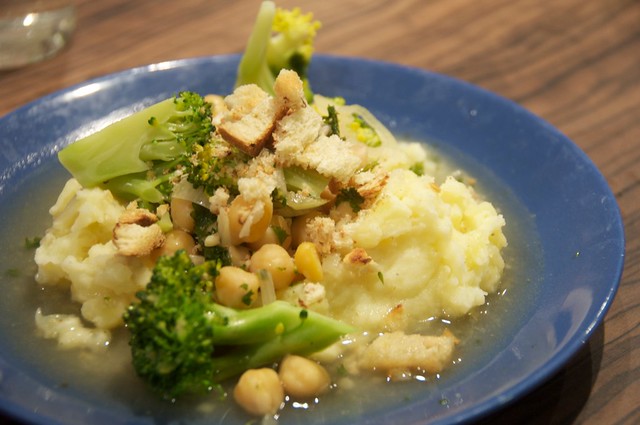
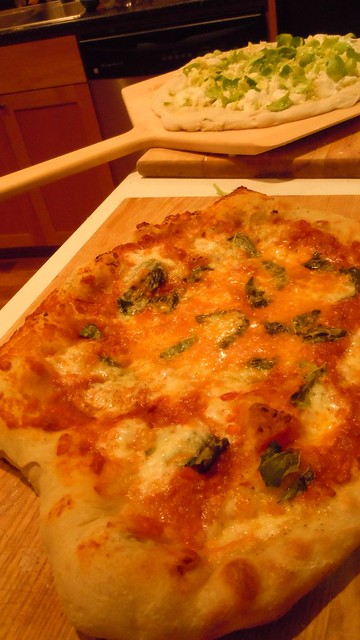
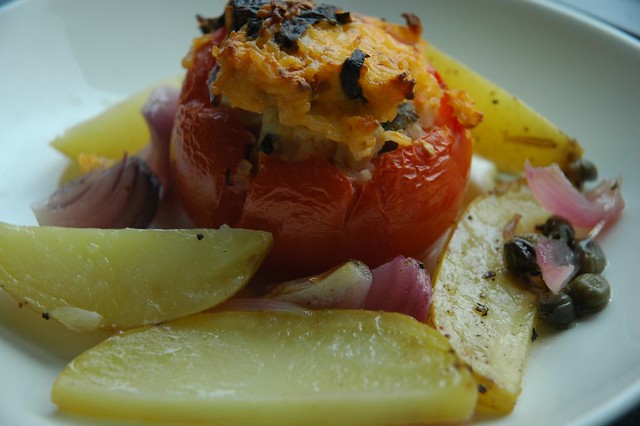
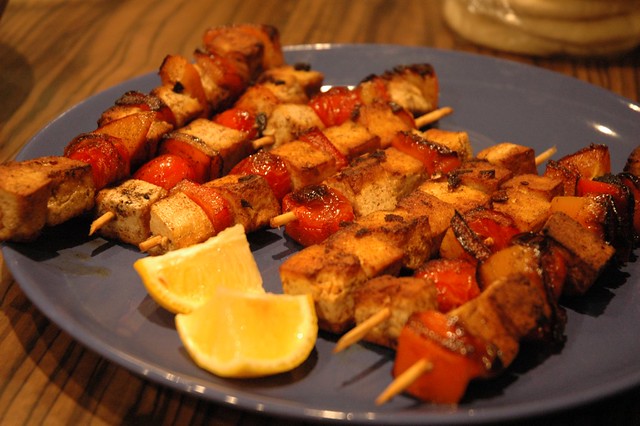
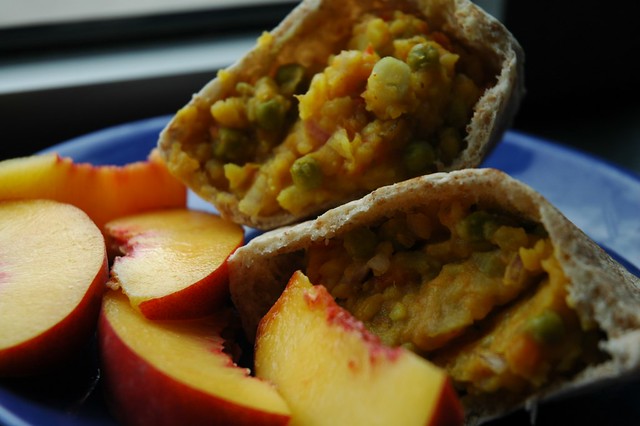
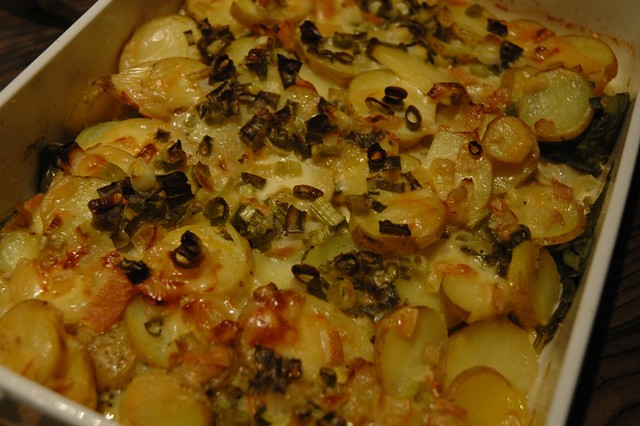
Wow, you ate those things last month? It's probably better than we did - Karl is a lucky man :) The tartiflette looks amazing - probably better than any that I've eaten in the past. The stuffed tomato brings back memories - good memories - of you two cooking AK and myself an gourmet meal during an amazingly cozy evening at your place. The pizza OTOH brings back good memories of you visiting us - I'm sad Karl couldn't be there. (BTW do you remember what exactly went on that Brussels sprouts pizza?)
ReplyDeleteGotta admit, haven't read the entire post yet (will do soon), but I remain amazed by the care & attention you put in these posts, and how enthusiastic you evangelize your beliefs with respect to improving food intake, as well as letting us think of food as an experience, not just a primary need.
Oh, and I noticed I'm different from you: I actually enjoy shopping ;-)
Nico, as always, thank you for your feedback! Did we mix capers and garlic in with the topping? I know you cut them up and then sauteed them. I do hate grocery shopping, but I love going to the markets. Today they were all bundled up and covered up with big huge plastic tents. The month of meals are more or less to plan, sometimes I mix them together and see what I want that week, or rotate. I do try and test every recipe before posting. Good times, we sure did make Karl jealous, I talked so much about your bread he refuses to bake it anymore =(
Delete